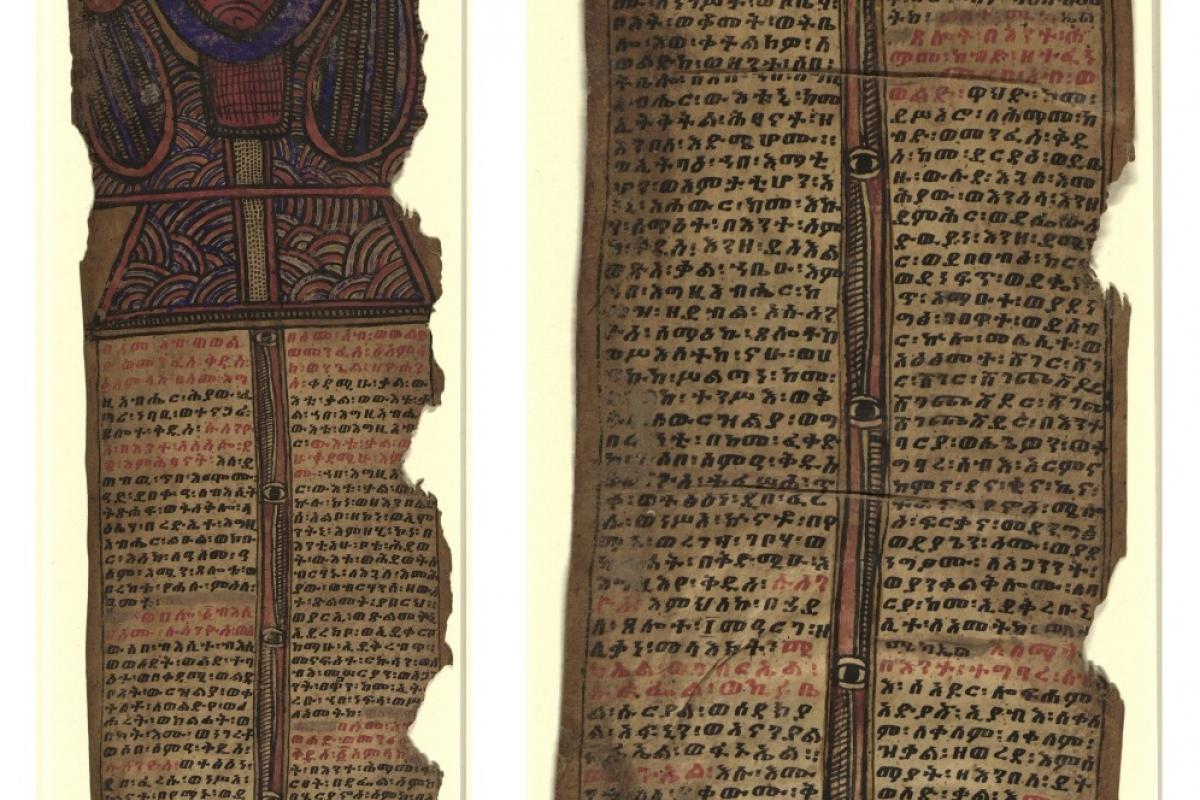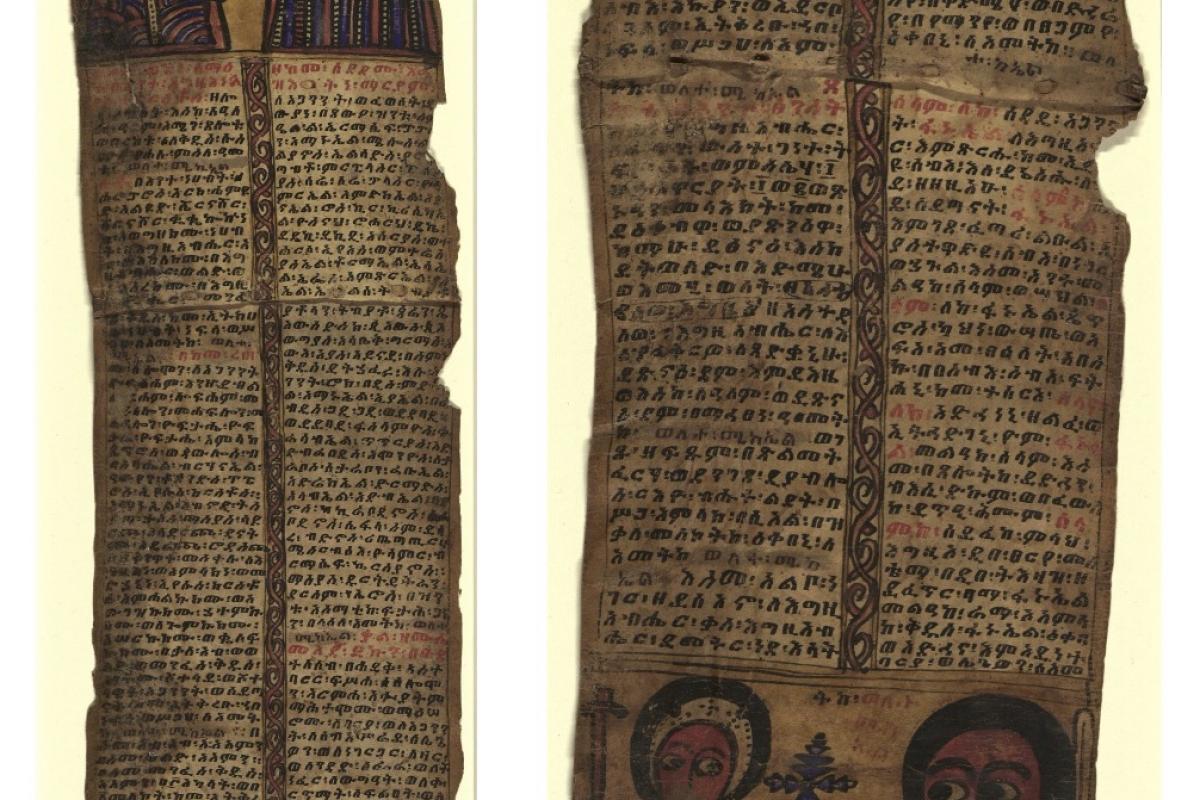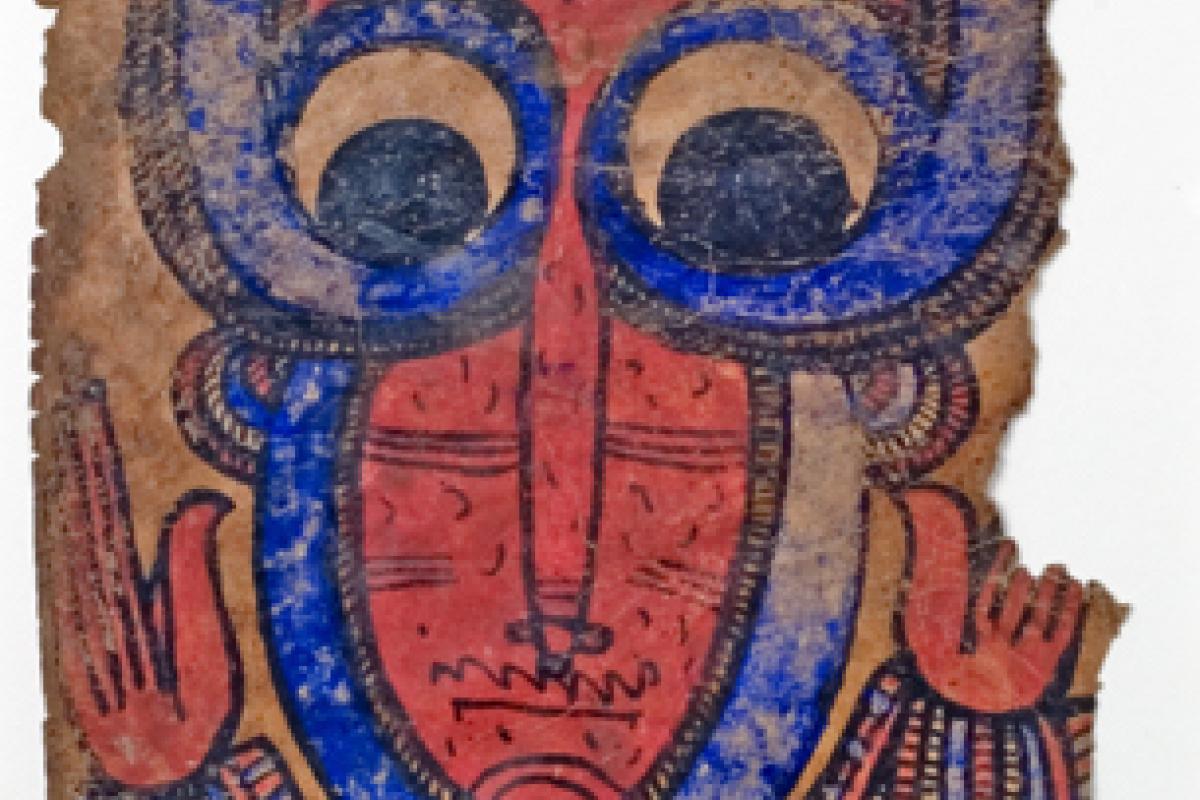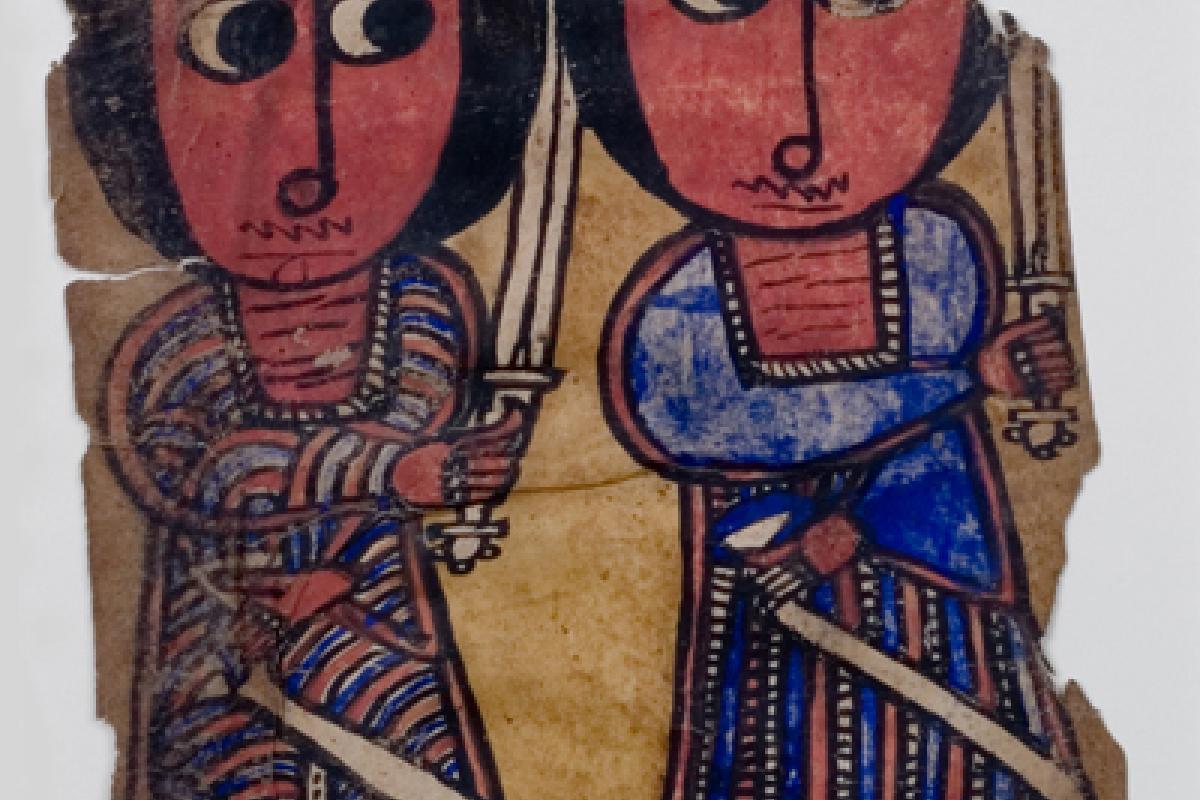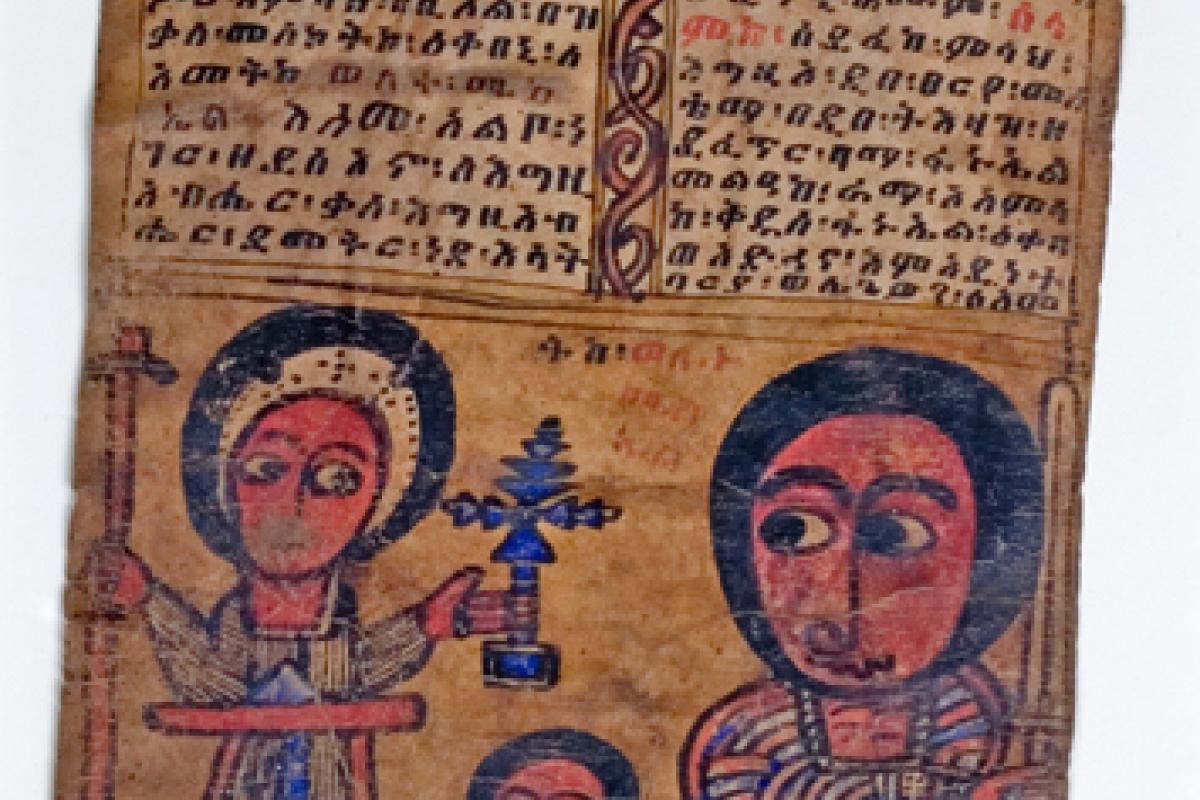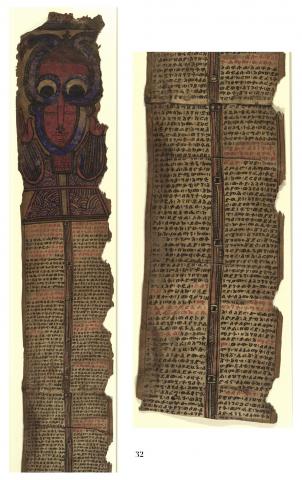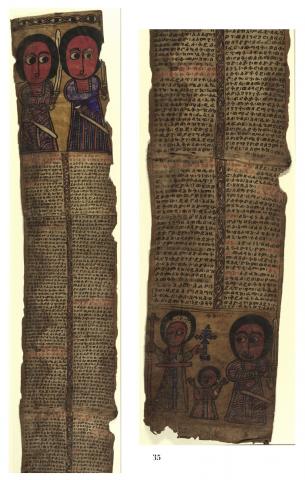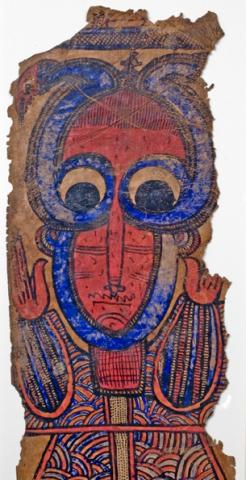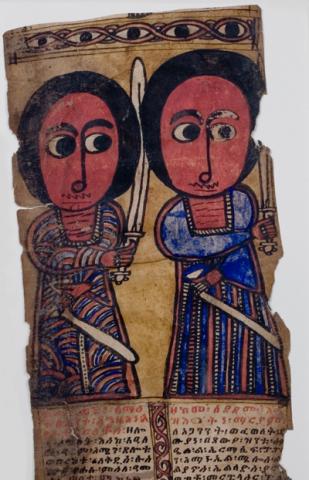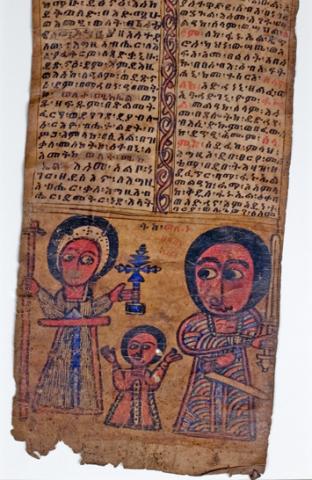Ethiopian Prayer Scroll
Podcast: Ethiopian Prayer Scroll
This podcast was researched and written by Karena Bennett, PSU student
Part of the Gift of the Word exhibition, Portland State University Library, Spring 2012
Ethiopian_Scroll_11.28.mp3, by mcclanan
Coptic, 19th century
Tigray Kifle Håger, Ethiopia
ink on vellum
length 192 cm (composite) | width 15 cm
Portland State University Library Special Collections, Mss 39
----------
Karena Bennett, Part of PSU's Gift of the Word Exhibit, Spring 2012
Additional Student Research by Natalie Hategan, Medieval Portland Capstone Student, 2011
This nineteenth-century Ethiopian magic scroll demonstrates the synthesis of sacred and heterodox elements: figures of angels appear alongside demon-like creatures; talismanic designs derived from Islamic, Judaic and pre-Christian folk sources blend with Christian prayers.[1] It is this unique convergence that invests the manuscript with its distinctive spiritual and medicinal function.
The creation of this object would have been relegated to a dabtara, a cleric in the Ethiopian Orthodox Church. For the scroll's devout owners, the inclusion of highly individualized prayers, imagery and arcane details endowed the object with its protective or curative abilities. During periods of crisis or sickness, it would have been kept with its owner at all times.[2] It was understood that this close relationship allowed the scroll to draw out and absorb the patron's pain or illness, which was thought to appear in the form of demons.
The script is written in Ge'ez, the liturgical language of Ethiopia. Areas that reference the specific patron have been covered and written-over, indicating that ownership of the manuscript was transferred at least once. The name Walatta, daughter of Michael, now appears, identifying her as the most recent owner.
The text and imagery relate to St. Susenyos who is affiliated with protection during pregnancy and childbearing providing evidence of how it functioned for Walatta, as well as its previous owners.[3]
Its strong palette of blue, black and red is characteristic of talismanic art produced in the northern Tigray highlands of Ethiopia. The majority of the script consists of prayers that appear in black ink while the name of the owner and other important details are presented in red. The scroll is comprised of four goatskin vellum sections that would have been originally joined vertically. The top register is occupied by a Gorgon. The figure's origin lies in the Greek Gorgon Medusa, as signified through the depiction of snakes, however this rendition recalls a later Byzantine version. The Byzantine Gorgon-like head is associated with the prayer of Susenyos, which is present within this scroll's text.[4] Two blue snakes outline the Gorgon's head, coiling to emphasizing the figure's overstated eyes. The motif of snake scales is repeated in the top-most decorative band of the scroll. A processional cross sits atop the Gorgon's head signifying his piety. It can be surmised the Gorgon is in fact an angel masquerading as a demon. Scholars note the common inclusion of disguised angels to fool a demonic presence.[5]
The central section portrays two guardian angels that are unnamed, but could be Saint Michael and Saint Gabriel because of their association with guardianship of mother and child. Each figure wields a sword further signifying them as protectors. The lower right image contains three figures. The character to the left holds a processional cross and leans on a prayer stick. He possesses the features typical of a guardian angel.[6] As with the Gorgon, these figures also possess exaggerated eyes. In addition, stylized eyes appear throughout the ornamental border, alongside other decorative patterns, and are a crucial aspect of the object's protective power. It is through the gaze of the owner and the illuminated eyes that the demon is ultimately defeated.[7]
Notes:
[1] Holland Cotter, "Ethiopian Magic Scrolls: Talismanic Art of Ethiopia," New York Times, May 19, 2011, http://www.nytimes.com/2011/05/20/arts/design/ethiopian-magic-scrolls-ta... (accessed 1 Oct. 2011).
[2] Jacques Mercier, Art That Heals: The Image as Medicine in Ethiopia (Munich: Prestel, 1997), 46.
[3] Steve Delamarter, interview by Anne McClanan, 8 July 2011.
[4] Mercier, Art That Heals, 99; Delamarter, interview.
[5] Mercier, Art That Heals, 95, 99.
[6] Delamarter, interview.
[7] Mercier, Art That Heals, 94-95.
Bibliography:
Dr. Steve Delamarter, interview with Professor Anne McClanan, July 8, 2011. Transcript available at PSU Special Collections.
Holland Cotter "Ethiopian Magic Scrolls: 'Talismanic Art of Ethiopia'," New York Times, May 19, 2011, accessed July 9, 2011, http://www.nytimes.com/2011/05/20/arts/design/ethiopian-magic-scrolls-ta...
Jacques Mercier. Ethiopian Magic Scrolls. (New York: G. Braziller, 1979).
Stefan Strelcyn. "Catalogue of Ethiopian Manuscripts of the Wellcome Institute of the History of Medicine in London." Bulletin of the School of Oriental and African Studies, University of London Vol 35, No. 1 (1972): 27-55. Published by: Cambridge University Press on behalf of School of Oriental and African Studies. Accessed June 23, 2011. http://www.jstor.org/stable/612793.
Wilton Barnhardt. Gospel. (New York: Picador USA,1995), 655-656.
Wolf Leslau. Concise dictionary of Gecez (classical Ethiopic). (Wiesbaden: Harrassowitz, 2010).

